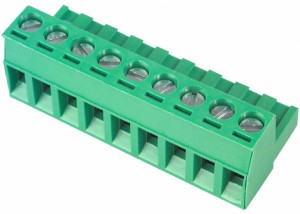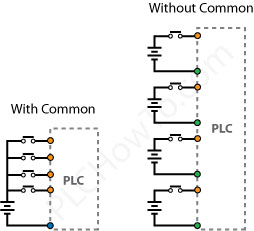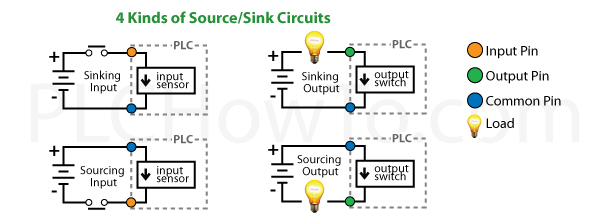![]()
 Physical Connections
Physical Connections
Most PLC connections involve connecting to something like the terminal block shown on the right.
Slide the wires into the slots on the bottom, and using the screws found on top, you secure the wires.  Some connectors are like the one shown, and disconnect from the PLC, while others are fixed to the the PLC.
This kind of connection is common for Inputs, Outputs and power supplies.
Internal Connections
The inputs and outputs of PLCs are connected internally in 1 of 3 ways: Relays, Source or Sink.  PLC manufacturers often produce all 3 versions, so you can select the version that best fits your application.  Below are descriptions of each variety and what their advantages/disadvantages are.
Lets go over a couple symbols that will be used.
![]()
DC Power
![]() Switch. ¬†It represents an input. ¬†Could be as simple as a light switch that you’re monitoring to see if it’s on or off.
Switch. ¬†It represents an input. ¬†Could be as simple as a light switch that you’re monitoring to see if it’s on or off.
![]() Load. ¬†It represents something you’re powering. ¬†Could be a light bulb or motor.
Load. ¬†It represents something you’re powering. ¬†Could be a light bulb or motor.![]() Juggling balls. (just kidding) ¬†Connections. They are the physical connections to the PLC discussed at the top of this page.
Juggling balls. (just kidding)  Connections. They are the physical connections to the PLC discussed at the top of this page.

PLC. This just tells you where the PLC fits into the equation.  Everything inside the dashed box happens inside the PLC.
![]()
Power Flow.  Shows which direction power flows through the circuit.
 Commons
Commons
In order to increase IO points on PLCs without increasing the number of connections, Commons are used.  The picture to the right shows an example of what the wiring of a PLC with 4 inputs would look like.  In the picture Without Common, the green points all lead to the same voltage source.  Commons take advantage of this frequent situation, grouping one side of connections together.  In this case we go from requiring 8 pins to requiring 5 pins, with no loss of functionality (assuming you wanted them tied to the same sources).  Commons are used in Relays, Sink and Source Circuits.
Relays
![]() Relays are the simplest Connection type.  They act like light switches that are turned on or off by the PLC.  They physically connect/disconnect 2 pins on the PLC.
Relays are the simplest Connection type.  They act like light switches that are turned on or off by the PLC.  They physically connect/disconnect 2 pins on the PLC.
Advantages: Use for both AC and DC connections, handle higher current than Source/Sink models.
Disadvantages: There are 2 kinds of Relays, Mechanical and Solid State. Mechanical involve moving parts, and thus have a limited lifespan. Solid State have no moving parts, but are very expensive.
Source & Sink
Source & Sinking is¬†used exclusively with Digital DC circuits. ¬†If the common pin is + polarity, it’s called a sourcing circuit. ¬†If it’s – polarity, it’s called a sinking circuit.

Advantages: No moving parts, so lifespan is long
Disadvantages: No AC support. ¬†Can’t handle significant current.
                                                                       
                                                                      

Leave a Reply